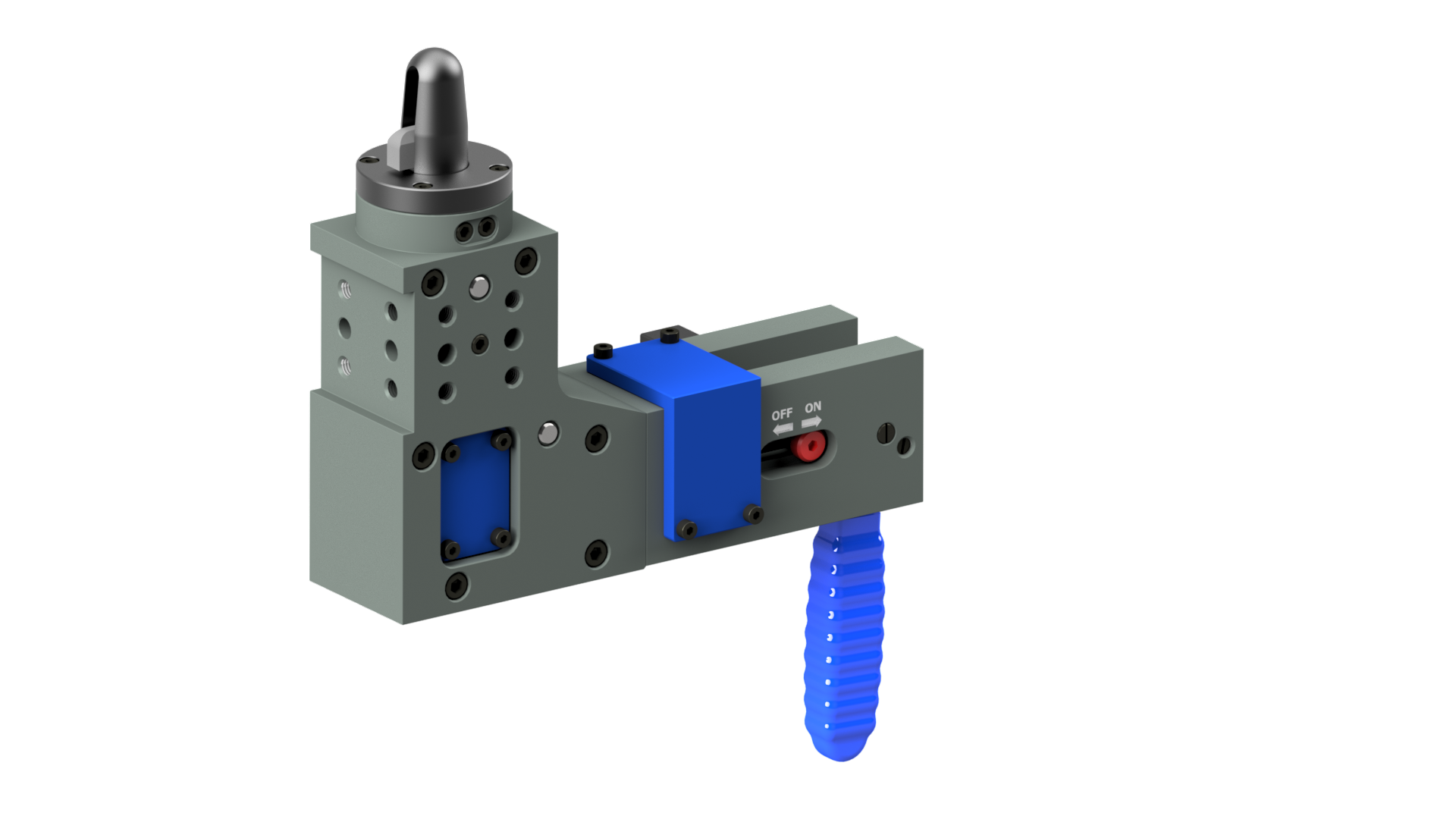Worcestershire, UK
Sandy Lane, Stourport, DY13 9QB
Send us a message
We reply within 1 day
+44(0)1299 823158
Available 9am - 5pm, Mon-Fri
Sandy Lane, Stourport, DY13 9QB
We reply within 1 day
Available 9am - 5pm, Mon-Fri
Shop hundreds of Toggle Clamp options from Sandfield Engineering – the clamp experts since 1965.
Sandfield Pneumatic Clamps are ideal for automated or repetitive holding applications.
A Pin Clamp, also referred to as a pneumatic pull-down clamp or an underbody clamp, is a clamping and centering device with a pin, ranging in diameter from 16 mm to 40 mm with a hook mechanism inside. What generally happens is the component, like a panel for example, is located over the pin, which positions and locates it, the hook comes from inside the pin and pulls down the components onto the pad of the clamp.
The original use of Pin Clamps was in the automotive industry where they are used to hold body panels and called underbody clamps, but this style of clamp has an application in any process where you need to hold down a component and locate it at the same time.
Pin Clamps typically involve a certain amount of customisation as the pin shape and size can vary as can the panel gap, typically from zero to five mm.

Pin Clamps are usually used as part of automated production processes and operated as a Pneumatic Auto Clamp where activation, opening and closing, is fully automated. We also provide an option for low volume production which allows for the Pin Clamp to be operated manually.
Pin Clamps are used in all manner of production processes where the requirement is to locate a component and hold it securely at the same time and clamp through a hole or slot.
One of the names we have mentioned is underbody clamp which refers to the most common, and original use of these types of clamp, which is to locate and clamp the underbody of a car during the production process. The panels will pass through a series of fixtures, located and clamped with the Pin Clamps, when the clamp is activated it pulls the panel down and holds it securely in position as the underbody passes along the production line.
In other cases, the panel is arranged on top of a trolley skid with the Pin Clamps mounted onto each of the fixtures. As the car body is loaded into each fixture the clamp is activated which locates and holds the panel securely.
One of the challenges with any Pin Clamp is that, because they have moving parts, the pin and hook mechanism, they tend to be prone to contamination from weld splatter or glue. This can be a problem in that the clamp will either stop working or get stuck . If the clamp sticks in the activated position and is securely held you can’t remove the component from the clamp. This often requires the panel to be cut off which can be costly if you consider that panel is most likely no longer usable and it is an obvious disruption to the affected production line for a period of time.
Our Pin Clamps have several features that we’ve designed to address this problem and ensure that our clamps withstand contamination to the fullest extent possible and that it is easily removed if it does find its way into the clamp.
The major considerations in specifying Pin Clamps are usually the space that the clamp needs to operate in, whether it is for an automated or manual process, the specific pin size and shape and the panel gap.
In most cases the customer will come to us with a requirement or specification, they will know for example the pin size and shape, and the panel gap they need. If what they require isn’t available off the shelf we will provide them with a data-sheet or a model. If they have any special requirements in terms of the pin shape we will work with the customer to make sure they get exactly what they need.
We’ve recently completed a project with Volvo where they came to us with a requirement for an acorn-shaped pin, with a certain parallel and taper which was their standard. We worked with them to develop a range of six Pin Clamps with two pin sizes and three different panel gaps to suit their particular applications.
The Pin Clamps that we supply have all been developed with customers so we have a range of base models that we can customise to ensure that the clamps we provide meet the customers precise requirement.
Sandfield hold stock of a certain amount of Pin Clamps with a standard pin shape and size, if those clamps meet the customers requirements they are available on short lead times. The standard Pin Clamp that we supply works with a pull down action. We also supply our XPCR 63 model with a hook that pivots, which enables the clamp to activate with the greatest distance from the pin and the greatest surface area. This Pin Clamp was developed with JLR for a particular requirement where they needed a certain amount of force and a certain amount of clamping at a set distance from the pin.
If they are used in a particularly hostile environment blowholes are increasingly important to give operators and maintenance the ability to clear any build up of weld splatter or dirt. In the worst case, where the build up is significant, there isn’t the option of clearing the clamps regularly, if the mechanisms that are built into the clamp stop working they will have to be stripped down and cleaned.
Pin Clamps are hardy pieces of kit that are expected to operate for a long life cycle. The only real issue, as we have discussed, is if you allow a build up of weld splatter in the clamp. We feel that the innovations that we have introduced go along way towards ensuring that this doesn’t happen in normal work environments.
The feedback that we have had from customers who have used our clamps alongside those of our competitors is that the Pin Clamps that we provide last longer, are easier to maintain and more reliable. Even in the most hostile environments where the clamps are filling up with sealant which is used to seal the panels, they carry on working for longer, they are also able to strip the product down, maintain it and put it back into production, which is not something they are to do with the comparable competitors’ products.


Sandfield Engineering has a range of several hundred different engineering clamps available in every variation of style, material, action, dimensions, finishes and power options to meet your specific requirements on short delivery times.

Sandfield Engineering Company are the toggle, power and bespoke clamp experts. We design and manufacture engineering solutions that keep production lines running smoothly. We provide custom engineered solutions, prevent water pollution and drive increased efficiency through automation.
Protected by SSL Encryption
| Cookie | Duration | Description |
|---|---|---|
| cookielawinfo-checkbox-analytics | 11 months | This cookie is set by GDPR Cookie Consent plugin. The cookie is used to store the user consent for the cookies in the category "Analytics". |
| cookielawinfo-checkbox-functional | 11 months | The cookie is set by GDPR cookie consent to record the user consent for the cookies in the category "Functional". |
| cookielawinfo-checkbox-necessary | 11 months | This cookie is set by GDPR Cookie Consent plugin. The cookies is used to store the user consent for the cookies in the category "Necessary". |
| cookielawinfo-checkbox-others | 11 months | This cookie is set by GDPR Cookie Consent plugin. The cookie is used to store the user consent for the cookies in the category "Other. |
| cookielawinfo-checkbox-performance | 11 months | This cookie is set by GDPR Cookie Consent plugin. The cookie is used to store the user consent for the cookies in the category "Performance". |
| viewed_cookie_policy | 11 months | The cookie is set by the GDPR Cookie Consent plugin and is used to store whether or not user has consented to the use of cookies. It does not store any personal data. |